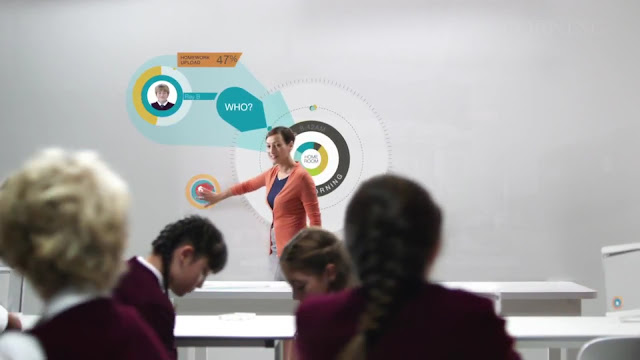Corning is a leading specialty glass and ceramics manufacturer. To showcase future uses of their glass, they created the video "A Day Made of Glass".
This video shows visions for home life, school, and work - all using touch sensitive glass that doubles as computer displays. I found the vision for the classroom of the future of particular interest. I'll break the scene down into separate pictures for further discussion.
The video shows two girls in school uniforms entering a modern elementary school building. Upon entering the classroom, they dock their tablet computers in their desks. [Click on picture to enlarge]
This action automatically uploads their homework and takes their attendance (as shown on the floor-to-ceiling screen in the front). The student's desk automatically opens a digital notebook for note taking, a calendar, a virtual keyboard, and a chat folder with student questions. From personal experience, typing on digital keyboards is cumbersome and slow. [Click on picture to enlarge]
The teacher uses her floor-to-ceiling touch screen to call up today's lesson: A physics lesson on optics. The wall screen also offers room controls (e.g. light dimmer). The teacher's actions on the main screen are mirrored on each students' screen. I don't know what the mirroring function serves: It seems it would distract students from looking at the main screen. [Click on picture to enlarge]
The teacher uses an interactive mindmap diagram to search through different topics. Through a drag-and-drop motion, the teacher transfers a physics activity to a multitouch table. I wonder if all the activities are created and scripted by for-profit education companies. This would leave the teacher hardly any creative freedom in which she could apply her expertise. [Click on picture to enlarge]
The students gather around the multitouch table for an optics activity. The students drag-and-drop color circles to explore additive color combinations. I found it noticeable that the class consists of only ten students. This optics activity could easily be achieved using real coloured glass and a light beam. Physics is about exploring the natural world, for which a computer activity provides no physical evidence. Computer-enhanced activities can be useful when showing phenomena that are too large/small or too fast/slow to experience directly. The goal should not become to replace all real-life experiments with computers simulations, but to carefully decide when which activity is more effective. [Click on picture to enlarge].
In a later scene, the students are seen on a field trip to a forest where they use their tablet computers for an augmented reality activity. [Click on picture to enlarge]
The Corning video makes no mention of the costs or durability of these glass-based tablet computers. Given the current financial situations of many public schools, such technology seems only affordable by wealthy private schools (as implied in the video).
The Corning video resembles Microsoft's vision of the classroom of the future:






Tegel Outlet Awesome post Thanks for sharing
ReplyDeleteRestaurant Brugge
ReplyDeleteamazing post awesome video thanks
business economy world
ReplyDeletethis video was amazing thanks 4 sharing this post with us
Thank you for sharing information about this new emerging technology. Being a homeschool Mom, I believe this technology will be used by online schools and homeschools many years before they can implement it into Public schools. Training so many low technology teachers in our public schools is going to be the problem. Every child over age 7 will own this technology in their smart toys, gadgets and glasses. However, once they get on the yellow school bus, the technology ends for the next 6 hours. It will be time to study for the next standardization test. I hope education in America does change soon. I believe education online or in AR will set this generation free. In a few years AR teachers could teach classes of 1,000's of children without a single child having to leave the comfort and safety of their homes. The AR teacher will have all the visuals and 3d printing can make any models or displays available as well in decade. We must rethink education. Thanks again for this wonderful information.
ReplyDelete